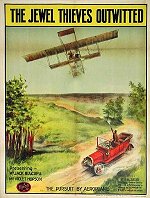In 1899, Cecil
Hepworth leased a house for 36£ a year and built an 8' by 15'
outdoor stage in his garden. This merger beginnings would become a studio
called Walton-on-Thames.
He founded Hepwix Production and initially,
he only produced 'actuality' films that were only about 50' in length. His
first films on his new stage was The Egg Laying Man where he utilized
trick photography and The Eccentric Dancer, where slow motion photography
was probably used for the first time in the UK.
He became famous with his coverage of the
funeral of Queen Victoria in 1901.
By 1905, Hepworth had expanded the studio
into 2 large covered stages, a workshop, viewing theater, drying rooms with
escape balconies, perferation rooms with 6 motor driven perforators to perferate
the film, copying rooms for film duplication and a length of rail for a
wheeled camera stand (today these are called 'track shots').
The actors for Hepworth (called the Hepworth Picture
Players) became so popular that without realizing it, Cecil had developed
Britain's first film stars. His stock company of players included such notables
as Henry Edwards, Violet Hopson, Stewart Rome and Chrissie White and later
to include Ronald Colman who became a star in the US.
By 1911, Cecil made the transition to feature
films. He concentrated on the beauty of the countryside and became skeptical
of some of the newer techniques of editing and close-ups (which eventually
was his downfall). Instead he chose to do film 'fade outs' and more stage
presentations.
 As
an alternative, Cecil did his own experiments, here you see that he was
one of the earliest known to have used an airplane in the story. This film
was released in 1913.
As
an alternative, Cecil did his own experiments, here you see that he was
one of the earliest known to have used an airplane in the story. This film
was released in 1913.
When WWI broke out, Cecil was one of the
few film studios that continued to produce. He made some propaganda shorts
to help sales of war bonds and public safety. He also rented out his studio
to other production companies that were without facilities.
At the conclusion of the war, there was
a surge of companies to get back into production AND to keep up with all
the advancements that the United States production companies had made during
the war.
To try to keep up, Cecil formed Hepworth
Picture Plays Ltd in 1919 to raise money for a new expansion program. This
was to be his downfall.
Hepworth purchased another property to build
a six stage studio and used Walton-on-Thames as collateral. Unfortunately,
the stock didn't sell well and his new films weren't the same quality as
those being released from abroad. He tried his hand at more elaborate productions
making several films that were financial flops.
In 1923 he spent £10,000 to make a
second version of Comin' Thro' the Rye. Six months later he had
to declare bankruptcy.
Creditors seized and liquidated Walton-on-Thames
studio at a small fraction of its value. Producer Archibald Nettlefold bought
the studio and renamed it Nettlefold Studio.
Back to British
Studios



